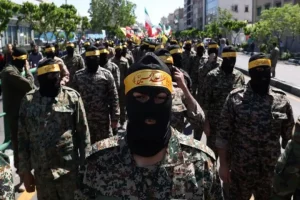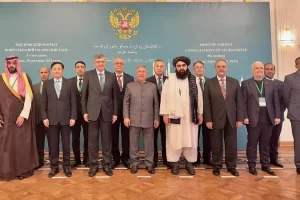A sweeping theme of Dabiq, now defunct magazine of the Islamic State of Iraq and Syria (ISIS), was death. “We love death like you love life,” the magazine quoted slain Al Qaeda chief Osama Bin Laden in one of its jihadist proclamations sometime between 2014 to 2016. The idea, according to ISIS researchers, was to instill terror in the group’s enemies and attract possible recruits by promising immortality in return for death on the path of jihad. Dabiq is no longer published and ISIS is also now a cornered and contracted group. However, the danger of death-driven ideology of terror persists as rigorously as ever.
ISIS – which is also known as ISIL or Daesh – emerged as the worst-ever terror group in recent history when it rampaged swathes of land in Iraq and Syria in 2014. Its ideology seeking establishment of a modern caliphate attracted thousands of Arab and foreign recruits. They included engineers, doctors, teachers, business executives, senior citizens, teenage girls and runaway wives. The group in fact eclipsed the global mascot of jihad, Al Qaeda, and reinvigorated terror outfits everywhere, including those in Pakistan and operating in Kashmir.
The roots of ISIS ideology are found in different strains of extremist ideologies and doctrines propounded by radical ideologues. The Islamic State’s ideology is multifaceted and cannot be traced to one individual, movement, or period. Its genesis can be traced to the immediate aftermath of Prophet Muhammad.
The various contours of ISIS ideology and its progenitors could briefly be understood through some following sub-headings.
Salafism, Wahhabism & Saudis
ISIS and Al Qaeda both have closely identified with the jihadist wing of a branch of Sunnism called Salafism, named after the Arabic al salaf al salih, the “pious forefathers”. These forefathers are the Prophet himself and his earliest adherents, whom Salafis honour and emulate as the models for all behavior, including warfare, couture, family life, even dentistry.
The group’s leaders explicitly adhere to this movement. For instance, in an audio speech from 2007, the head of the ISIS at the time, Abu Umar al-Baghdadi, made a call “to all Sunnis, and to the young men of Jihadi-Salafism (al-Salafiyya al-Jihadiyya) in particular, across the entire world.” The same year, his deputy referred to the ISIS’s combatants as being a member of “the current of Jihadi-Salafism.”
Shortly after the establishment of the Islamic State in Iraq, a speech by its leader Hamid al-Zawi (Abu Umar al-Baghdadi) entitled “Truth Has Come and Falsehood Has Perished” was published on December 23, 2006. pic.twitter.com/FKtPZjKSQR
— Bedouin Researcher (@TheBedouinPoet) October 14, 2022
The Jihadi-Salafism is not merely a series of fiery sermons, it includes a vast network of academics, blogs, media outlets, and most lately, innumerable social media supporters. The movement is founded on an extreme and minoritarian interpretation of the Quran that is textually exact, deeply entrenched in a pre-modern theological tradition, and has been substantially expounded by a reputable cadre of religious authorities.
A distinctive Salafi intellectual history dates to the Middle Ages. The main body of Salafi theological literature comes from the teachings of the Syrian Hanbali scholar Ibn Taymiyya (d. 1328) and his pupils. The Wahhabi movement, or Wahhabism, a branch of Salafism founded in the Arabian Peninsula by Muhammad ibn Abd al-Wahhab (d. 1792) produced later major Salafi thinkers. Wahhabism was wed to the Saudi political system in the late 18th century and is still wedded to it now, though ideology in Kingdom is mutating rapidly under the political stewardship of Crown Prince Mohammed bin Salman. By engaging in jihad against alleged heretics in order to eradicate shirk and uphold tawhid, the Saudis assisted the Wahhabis in spreading their brand of Islam throughout Arabia. Wahhabi jihad included enforcing appropriate ceremonial practices, destroying tombs and shrines, and other acts of worship of entities other than Allah.
An explanation of Muhammad Ibn ‘Abd al-Wahhab’s Kitab al-Tawhid pic.twitter.com/LD3Nlvukco
— إبراهيم الكُوبي الأَثري (@IbrahimAlkoobee) September 1, 2022
Jihadism’s anti-Shia sentiment is a result of Salafism’s earlier hostility to Shias. For instance, in 1792, Saudi Wahhabi soldiers attacked al-Ahsa, a Shia center in eastern Arabia, in an effort to eradicate Shia practices there. They later invaded Najaf and Karbala, the two holiest Shia shrine cities in Iraq, plundering Karbala and slaughtering tens of thousands of people. Leading Wahhabi thinkers in the Saudi kingdom attempted to forcibly “convert” or expel the Shia of the nation’s eastern province as late as 1927. Although the anti-Shia conflict is no longer actively being fought by the present Kingdom of Saudi Arabia, and under its Crown Prince Mohammed Bin Salman, the kingdom is shedding Salafist obstinacy very fast and has recently embarked on a course of détente with the Shia state of Iran.
Muslim Brotherhood’s Caliphate Plan
The thrust of ISIS ideology on establishing a global caliphate and assembling world Muslims under one umbrella is largely inspired from the Muslim Brotherhood of Egypt. However, the overall texture of the Brotherhood doesn’t seek violence as a way to achieve targets and is mostly doctrinaire organisation.
The Brotherhood, which Hasan al-Banna founded in 1928 as a political organisation devoted to seizing control of society and the state, has never been as dogmatically strict as modern jihadis. Although the Brotherhood is a movement that is entirely Sunni, it does not have an adamant animosity towards other Islamic sects, such as Shias, or ideologies, such as Sufi mysticism. The movement was created in reaction to the expansion of Western imperialism and the resulting loss of Islam in public life, tendencies that it attempted to reverse through grassroots Islamic engagement.
1 April 1929,94 years ago, in Cairo, the #muslimbrotherhood emerged. An organization that will characterise the entire history of #Egypt and the “arab world”.
In the picture its founder Hasan al-Banna. pic.twitter.com/haeMy4OMCR— Mattia Giampaolo (@Mattia88261) April 1, 2023
The founder of the Brotherhood talked extensively about the caliphate. He once said: “Islam forbids the Muslim community from being divided among states and demands that the Muslim community unite around one leader or one head, the head of the Islamic State.” In another place, Banna said: “The Muslim Brotherhood places the caliphate concept and efforts to restore it at the forefront of its plans.”
Takfirism
ISIS is a product of the takfiri schools and ideologies that have developed out of Al-Qaeda. The development of the ISIS ideology can be better understood by contrasting the vision of the organisation with that of Al-Qaeda and identifying where their paths diverged. Early meetings between Osama bin Laden and Abu Musab al-Zarqawi are the origin of differences between Al-Qaeda and ISIS. As their successors do today, bin Laden and al-Zarqawi had different views on the use of extreme violence and the targeting of Shia people while they were in Afghanistan in the 1980s. ISIS claims that the adversaries of Islam are the worst.
The practice of declaring others as kafirs, and adversaries worthy of elimination, is known as takfir. ISIS is extremely rigid in following takfir and it has made it the most dangerously sectarian group.
Sami al-Aridi, the head cleric of the Al-Qaeda-affiliated Nusra Front, which has been active in Syria, laid forth some of the principles that set the ISIS apart from previous jihadi organisations like Al-Qaeda in a video interview that was published online in October 2013. Al-Aridi highlighted mainstream Wahhabi clerics like Saudi Arabia’s the grand Mufti Abd al-Aziz Al al-Sheikh and well-known theologian Abd al-Aziz Ibn Baz as acceptable experts in opposition to ISIS. He pointed out that Al-Qaeda is more tolerant of Muslim clerics than ISIS, frequently engaging them, and upholds the four Sunni schools of law.
Families of US soldiers who were killed by #ISIS have sued the French company LaFarge, which pleaded guilty earlier this year to paying bribes to the ISIS and Al Nusra Front to keep a cement plant in #Syria operational during the war.
📸 pic.twitter.com/XDDw7KyoYm— Mete Sohtaoğlu (@metesohtaoglu) December 27, 2022
ISIS, on the other hand, believes that clerics play a significant role in the continuation of oppressive, illegitimate governments throughout the Muslim world.
Al-Sahwa Al-Islamiyya (Islamic Awakening)
The ISIS draws on the jihadi writings of both ideologues who share its viewpoint and clerics who do not officially support the organisation. Many of these clerics are direct descendants of the Sahwa, an intellectual religious movement that started in earnest in the 1970s, and they hold to a set of beliefs that drastically depart from mainstream Islam. The movement’s core doctrines were shaped by the fundamentalist tenets of Qutbism (ideas emanating from writings of Syed Qutb of Egypt) such as theological denunciations of democracy and the belief that contemporary governments of the Muslim World have apostatised.
Safar al-Hawali, Muhamad Qutb, Muhammad Surur and Salman al-Ouda are the main scholarly representatives of this movement. The Sahwa movement’s calls to forcibly expel American troops from the Islamic World inspired numerous pan-Islamist militant networks, including ISIS and others that continue to thrive in some form or the other in largely Asian and African countries.
Also Read: Not Wahabi hardliners but Ahle Quran group is behind MBS’ bold reforms in Saudi Arabia




















